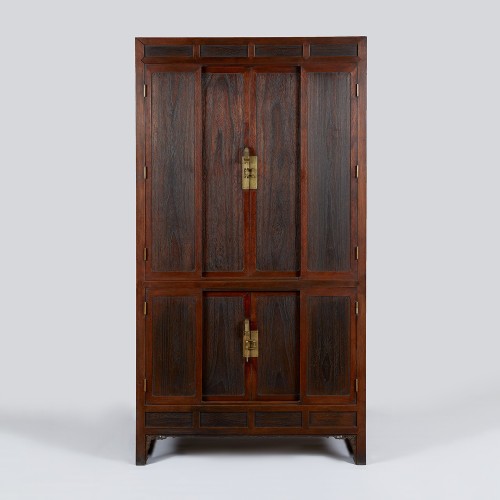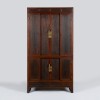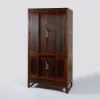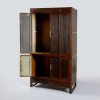본문
관복장은 조선시대 양반 계층이 관복(官服)을 보관하기 위해 사용한 고급 목가구입니다.
조선시대의 관복은 관직자의 신분과 품계를 나타내는 예복으로, 주로 양반 이상 계층에서 공식 의례나 업무 수행 시 착용하였습니다. 관복장은 이러한 관복을 보관하기 위한 전용 장으로 신분과 권위를 상징하는 용도로도 볼 수 있습니다.
이 관복장은 문틀의 구조와 내부 판재 구성이 휨과 뒤틀림을 방지하도록 정밀하게 제작되었습니다. 상하 이단 분할 구조로 구성되어 있으며, 문판은 어두운 색감의 나뭇결이 살아 있어 전체적으로 중후한 인상을 줍니다. 문의 중심에는 금속 장석(裝飾)이 부착되어 있으며, 간결한 형태로 장식성을 절제하면서도 목재 고유의 질감과 조화를 이루는 전통 양식의 미감이 잘 드러납니다. 특히 문이 여닫이와 미닫이로 함께 사용하는 안고지기장으로 제작되었습니다. 또한, 하부 구조에는 다리가 있어 바닥의 습기를 방지하는 실용성을 확보함과 동시에 전체적인 균형미를 이루고 있습니다. 이뿐만 아닌 다리의 하단부에는 특징적인 조각이 있어 미적 요소도 보입니다.
관복장은 단순한 수납가구가 아니라 사회적 지위와 예를 중시한 문화를 상징하며, 조선 후기에 양반층이 가구에 실용성과 심미성을 어떻게 접목하였는지를 보여주는 유물입니다.
━━━━━
官服柜是朝鲜时代两班阶层用于收藏官服的高级木制家具。
朝鲜时代的官服是象征官员身份与品阶的礼服,通常由两班以上阶层在正式仪式或公务场合中穿着。官服柜作为专门用于保存官服的家具,同时也具备象征身份与权威的意义。
本件官服柜在结构上经过精密设计,框架与内部板材的结合有效防止木材变形与扭曲。柜体为上下两段式构造,柜门采用深色木纹,展现出沉稳厚重的视觉印象。门中央饰有金属装饰件,形制简练,既保留了装饰性,又与木材天然质感相得益彰,体现出传统家具的审美特征。特别值得注意的是,该柜为推拉门与对开门并用的安古支器柜。柜体下方设有高脚结构,不仅可防潮,也增强整体比例的协调感。腿部下端雕有具有特色的纹饰,增添了装饰美感。
官服柜不仅是一件实用家具,更象征了朝鲜后期重视礼仪与身份的两班文化,同时也展示了当时上层社会如何将实用性与审美性巧妙结合于生活器物之中。
The Gwanbokjang (a ceremonial robe chest) is a finely crafted wooden chest used by the yangban (Joseon elite class) to store gwanbok—official court attire that signified one's rank and position.
In the Joseon Dynasty, gwanbok was a type of ceremonial clothing worn by officials, primarily by the yangban class, during formal events or official duties. The gwanbokjang was a dedicated storage piece for such garments, also functioning as a status symbol reflecting the owner's authority.
This chest was constructed with precision to prevent warping or twisting, evident in its carefully designed frame and inner panels. It features a two-tier structure, with doors made from richly grained, dark-toned wood, giving the piece a dignified appearance. Metal fittings are attached to the center of the doors, and though minimal in form, they harmonize with the natural texture of the wood, exemplifying the aesthetics of traditional Korean furniture. Notably, the chest uses a hybrid door style that combines hinged and sliding mechanisms.
The lower structure is elevated on legs, which not only prevent moisture damage from the floor but also provide visual balance. Decorative carvings on the lower ends of the legs add further aesthetic refinement.
Far from being just a storage item, the gwanbokjang embodies the culture of social hierarchy and formality. It serves as a valuable artifact that reflects how the Joseon yangban class integrated utility and beauty into their furniture design during the late dynasty.



